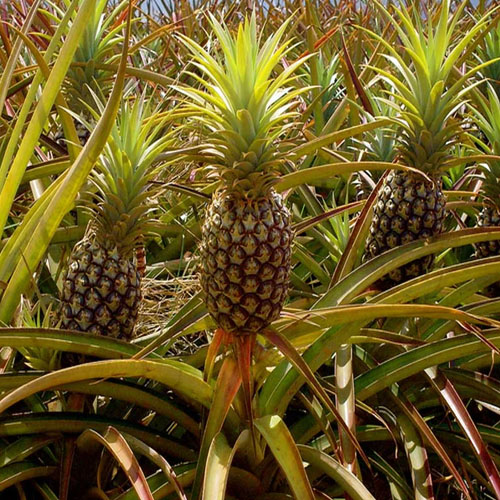Pineapple Plants
Pineapple Plants (Ananas comosus) are tropical fruit-bearing plants known for their sweet, juicy fruit with a distinctive spiky exterior and vibrant yellow flesh. Originating from South America, pineapples are a popular fruit grown in tropical and subtropical regions worldwide. They are not only valued for their delicious fruit but also for their ornamental appearance, making them a unique addition to gardens.
Characteristics of Pineapple Plants
-
Size and Growth Habit:
- Pineapple plants are herbaceous perennials with a rosette of stiff, spiny leaves that can grow up to 3-5 feet (0.9-1.5 meters) in diameter and height.
- Each plant produces a single fruit in the center, supported by a thick stalk.
- Pineapples are shallow-rooted, with roots extending mainly in the top 12-18 inches (30-45 cm) of soil.
-
Leaves:
- The leaves are long, sword-shaped, and arranged in a spiral pattern, with spines along the edges. They can be green, yellow, or variegated, depending on the variety.
- The leaves are tough and waxy, helping to conserve water in hot climates.
-
Flowers:
- Pineapple plants produce a central flower spike from the rosette of leaves. The flowers are small, tubular, and typically purple or red, blooming in clusters.
- After pollination, the flowers fuse together to form a single, large fruit.
-
Fruit:
- The pineapple fruit is a composite fruit, formed from the fusion of multiple flowers. It has a rough, spiky skin that ranges in color from green to yellow or reddish when ripe.
- The flesh is bright yellow, sweet, and juicy, with a tough, fibrous core at the center.
- Pineapples are rich in vitamins C and B6, manganese, and dietary fiber, and contain bromelain, an enzyme with anti-inflammatory properties.
-
Lifespan:
- Pineapple plants can live for several years. After fruiting, the main plant typically dies back, but it produces suckers or “pups” around its base, which can be used to propagate new plants.
Growing Conditions
-
Climate:
- Pineapples thrive in tropical and subtropical climates, preferring temperatures between 65-95°F (18-35°C).
- They are sensitive to frost and prolonged cold temperatures, which can damage the leaves and fruit.
-
Soil:
- Pineapples prefer well-draining, sandy, or loamy soil with a slightly acidic to neutral pH (4.5-6.5).
- Good drainage is essential to prevent root rot, as pineapple plants are prone to standing water.
-
Sunlight:
- Pineapples require full sun for optimal growth and fruit production, needing at least 6-8 hours of direct sunlight daily.
- In extremely hot climates, some afternoon shade can help prevent sunburn on the leaves.
-
Watering:
- Pineapples are relatively drought-tolerant once established but need regular watering during the initial growth period and while fruiting.
- Water the soil around the plant, not the center, to prevent crown rot, and allow the top inch of soil to dry out between waterings.
Care Requirements
-
Mulching:
- Mulch around the base of the plant with organic material like straw or wood chips to retain soil moisture, suppress weeds, and regulate soil temperature.
- Keep mulch away from the base of the plant to avoid rot.
-
Fertilization:
- Pineapples benefit from regular feeding with a balanced fertilizer or a formula high in nitrogen during the early growth stages.
- As the plant matures and begins to fruit, switch to a fertilizer higher in potassium to support fruit development. Apply fertilizer every 2-3 months during the growing season.
-
Pest and Disease Management:
- Common pests affecting pineapples include mealybugs, scale insects, and nematodes. Diseases such as root rot and heart rot can also occur, particularly in poorly drained soils.
- Implement integrated pest management (IPM) practices, including using beneficial insects, organic treatments, and proper sanitation to manage pests and diseases.
-
Propagation:
- Pineapple plants are typically propagated from the “crown” (the leafy top of the fruit), “suckers” (side shoots that grow around the base of the plant), or “slips” (small shoots that grow between the leaves and the fruit).
- To propagate from the crown, twist off the top of a pineapple fruit, remove a few of the lower leaves, and let it dry for a few days. Plant the crown in well-draining soil and water sparingly until roots develop.
-
Harvesting:
- Pineapples are usually ready to harvest when the fruit turns yellow and emits a sweet aroma. The “eyes” on the skin should be flat and golden yellow.
- Harvest by cutting the fruit from the plant with a sharp knife, leaving a small portion of the stem attached to the fruit to prevent damage.
Additional Tips
-
Container Growing:
- Pineapples can be grown in containers, making them suitable for patios or small gardens. Choose a large pot with good drainage and use a well-draining potting mix. Container-grown plants may require more frequent watering and fertilization.
-
Temperature Sensitivity:
- In cooler climates, pineapples can be grown indoors or in greenhouses to protect them from frost and cold temperatures. Ensure adequate sunlight and maintain a warm, humid environment.
-
Weed Control:
- Keep the area around the plant free from weeds, which can compete for water and nutrients and harbor pests and diseases.
-
Flower Induction:
- If a pineapple plant is not flowering after about 12-18 months, you can induce flowering by placing a ripe apple in the center of the plant. The ethylene gas released by the apple stimulates flowering.
-
Nutritional Benefits:
- Pineapples are packed with vitamins, minerals, and antioxidants, making them a healthy addition to any diet. They are commonly used in fresh fruit salads, smoothies, desserts, and as a garnish for various dishes.
If you have any specific questions about growing or caring for pineapple plants or need more details on a particular aspect, feel free to ask!


